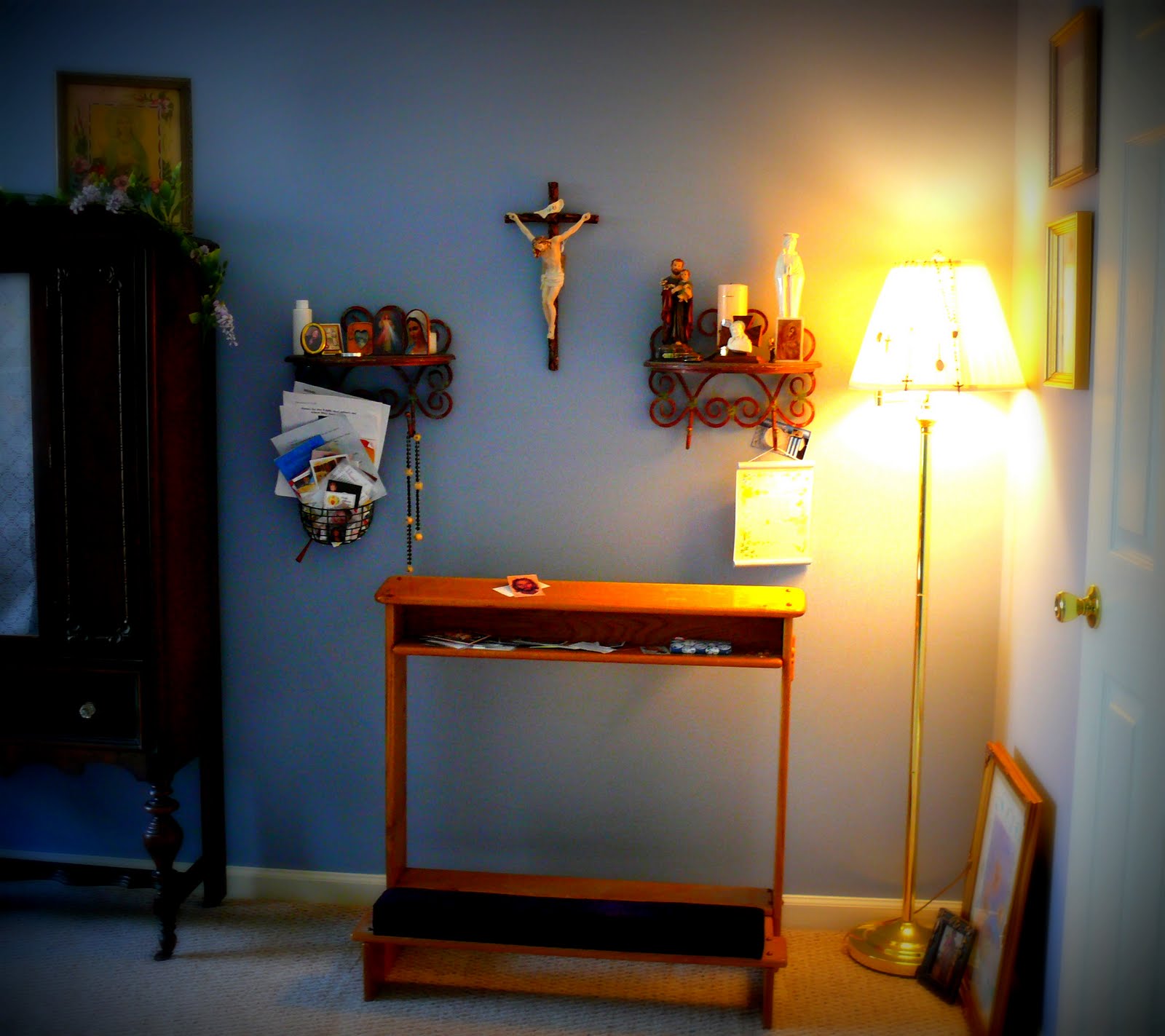Prayer Altars, Idolatry, and Grace
Oct 6th, 2014 | By Guest Author | Category: Blog PostsThe following essay is a guest contribution by Tacy Williams Beck. She received a BA from Covenant College in English, with experience teaching English, Rhetoric, and Dance. Tacy and Stephen lived in Maryland for seven years, and they have four children: three girls and a boy. Their family was received into full communion with the Catholic Church on Easter, 2011 and now live in Tennessee. Stephen described that journey in a CTC interview we posted in 2011. Tacy currently writes for Real Housekeeping. See also her articles for Catholic Mom, and Dappled Things at those links. She likes to read, bake, sew, and, of course, write. Follow her on Pinterest here.
A few years ago, while living further North, I remember seeing a private kneeler while out poking about for a new Fall wardrobe. I’m not sure if it was for sale (it was always there, untouched, after all), but it always called to me through the dusty air, sitting by a shining window in a ramshackle Lutheran thrift shop in Annapolis, Maryland. At about the same time I spotted it there, as it so followed, my husband approached me about the idea of purchasing a kneeler for our home. We had recently become Catholic. After converting from reformed Presbyterian- even educated at Covenant College- and spending a few years studying in California before that, I did have my questions about things like prayer kneelers. My husband was a student at St. John’s College at the time. Together, we had a lot of questions. One question brought up more questions, and on and on it went. Ad infinitum. It was very startling and humbling.
My first thought was, “Why can’t you just pray?!” Why do you have to have a thing in your home in order to allow you to pray? Why can’t you just simply kneel down on the floor and PRAY, for crying out loud? The ultimate concept was – are you even praying in the first place? Isn’t it materialistic to express that need for prayer – that beautiful, humble reliance on prayer through the use of spiritual objects? Are the spiritual objects stumbling blocks? Really? Are they? Can a private kneeler or a prayer altar become a form of idolatry?
John Baillie wrote in the Protestant book A Diary of Private Prayer:
O Lord my God, I would kneel before thee in lowly adoration ere I set out to face the tasks and interests of another day.
In this way, he humbles himself to private prayer before attempting to succeed in the tasks awaiting him in the hours that come. Did he need anything else besides his knees, his hands folded in prayer, in order to engage in satisfying prayer? A Protestant friend contested this idea that we need aids to prayer, simply because she felt that this movement suggested the following question: how are prayer altars not a form of idolatry for Catholics?
Recently, as part of the New Evangelization for young Catholics, a movement to reclaim our culture through the transformation of the home through the use of the Liturgy of the Hours has begun.1 In addition to praying the hours, the use of prayer altars is on the rise, used to bring out the essential quality of seeking after the will of God as a visual means of grace and peace. But it is nothing new. For centuries, Catholics have used beads, kneelers, shawls, and other garments or items to remind them how to pray and how many times to pray. A book or even an iPad could be used as an aid to prayer. Are these things idols, or can they be idols?
Scripture says we should have the Word written on our doorposts. We should think about it in everything we do, coming out or going in. But does this mean we should have laminated print-ups of Psalm 23 with a clip-art of some sheep adorning its sides? Should we seek the costly in addition to the free? In everything we should seek to do better- and even in this, art expresses something significant. That art should have value and excellence. Therefore, from this perspective, I have several problems – or more generously put, qualms – with with the idea that we should not have prayer altars in our homes.
Yet, I know what my friend meant by that question. I remember how many things made me uncomfortable as an Outsider looking into the Catholic Church, asking the Catholic Question. The idea of a prayer altar may seem like a “fancy extra.” For some odd reason, a strange image popped into my mind. I imagined a nun sitting on a bench, wearing a collar of medals similar to a member of the military. It would seem odd, if not show-offish, to so proclaim one’s achievements so obviously. Particularly because these are spiritual accomplishments. If someone hangs rosaries and frames Catholic art, can it not seem in some way to be a roadblock? Are rosary beads a distracting goody? If we are trying to be “All things to all people,” even the poorest among us, would it seem a costly way to merely better our homes? Would Elisabeth Elliot have brought fancy things as she witnessed to the Auca Indians of Ecuador? How can it be purely a good thing?
Under first consideration, I believe that we must not seek to strip the Church of its beauty. When the orders of the Catholic Church first began, the Dominicans, Benedictines, and others had to first explain the doctrines of their order. Often in the Protestant world, if we strip what is bad from a church, we end up stripping too much. If we remove images from our worship, we no longer have art in the Church as an outlet for Spiritual Expression. Ornateness is found in not every place or culture, but that does not render ornateness evil. In no vague terms, this wrong teaching concerning images has probably hurt and stripped hope and dignity from many would-be excellent Christian artists.
Second, anything can become idolatrous. A prayer like the Rosary, that may seem idolatrous because it is formulaic, is not necessarily so. A simple prayer on your knees, or a praise song, might be done self-righteously. It may be the case that a song, or prayer is predictable, but not in a negative, slavish way. Like a poem, a prayer like this is a set form and in this way, it is a good thing. Additionally, it is possible that the Christian might fall into temptation to sin, in even the most sparse surroundings, and without any aids to their prayers. This also begs the question- why would you pray the Rosary, or pray a novena using Rosary bead, if you do not venerate Mary? That is in itself a very important question.
Third, only the Catholic Church- in the form of monasticism, etc- renounces such idols as possessions, etc. In the cloistered life, these things are given up. What does this mean and what are its implications? Obviously many Protestant missionaries or those called to minister to the poor must give up many things in life. In becoming Catholic, I became convinced of the importance of cloistered living! It is so hard to have a fully set apart and holy life in our modern world today. I found, over time, that as I asked my many harrowing questions, the Catholic faith had a very good answer to that question.
Fourth, we should reexamine what the altar really means in the Catholic Church. The Catechism of the Catholic Church says: (1181) And I quote: “A church, a house of prayer in which the Eucharist is celebrated and reserved, where the faithful assemble, and where is worshipped the presence of the Son of God our Savior, offered for us on the sacrificial altar for the help and consolation of the faithful- this house ought to be in good taste and a worthy place for prayer and sacred ceremonial. In this ‘house of God’ the truth and the harmony….. should show Christ to be … active in this place” (emphasis mine). The altar is really the place where the sacrifice literally took place in the Jewish tabernacle. Today, it is the place where the Eucharist is given, where we are reminded that Christ took on flesh. To put a prayer altar in your home- such as table with an icon or candles, but it doesn’t have to look this way- is to have a center of gravity, the locus of energy, the heart of the home which shows Christ to be our center.
We must also consider what prayer really means. According to the Catechism: “To meditate on what we read helps us to make it our own by confronting it with ourselves…. There are as many and varied methods of meditation as there are spiritual masters. Christians owe it to themselves to develop the desire to meditate regularly, lest they come to resemble the first three kinds of soil in the parable of the sower. But a method is only a guide; the important thing is to advance, with the Holy Spirit, along the one way of prayer: Christ Jesus.” (Catechism of the Catholic Church 2706-2707). While the West developed the Rosary as a replacement for the Liturgy of the Hours it is indeed one way to advance and come to a closer relationship with Jesus Christ.2
We should not criticize that which makes our faith beautiful. We have every reason to continue to build up the place of beauty, the center of gravity in our church and in our homes. That place that we gather around, it is and I quote, “the altar of sacrifice and the table of our Lord.” (Catechism of the Catholic Church-cite). I must close by admitting that my husband and I never, in fact, ended up purchasing a private kneeler. We talked about it, but we never went through with it. I suppose we’re still thinking about it. We did, however, set up a prayer altar with a painting of the crucifix, several rosaries, and a candle and vase of flowers. We are very glad we did.
- blessedisshe.net contains devotionals written by Catholic women, corresponding to the Liturgy of the Hours. The book The Little Oratory, written by Leila Lawler, 2014 concerns prayer altars in the home. [↩]
- See Catechism 2678: “Medieval piety in the West developed the prayer of the rosary as a popular substitute for the Liturgy of the Hours.” [↩]




I like the organized compartmentalizing of the rosary. To the kneeler I would say 1 Thessalonians 5:17 reveals that prayer is not an isolated activity but more like a mindset. I like the artwork in the windows at lmpc because it is clearly instructive. God is logical. So if there is artwork shouldn’t it remind of the grander scheme? So glad for your entry here and glad I stumbled over it.
Thanks, Evan, for the comment. I hope to encourage transparent discussion about the Rosary , the Liturgy of the Hours, and some other concepts. I’m not sure what you meant by “organized compartmentalizing,” but I hope that if you like my explanation, it was helpful to you. Your mention of the windows (I’m assuming the stained glass?) reminds me that ornateness is not exclusive to the Catholic Church- of course not- but that’s a good starting point for this discussion.